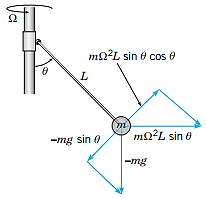
In the following problem, we ask the reader to some of the details left out of the above discussion, to analyse the closed-loop system for the stability properties, and to conduct a numerical simulation of the nonlinear system.
Work out the details leading toEq. (1).
The expression for
Answer to Problem 1P
Solution:
The expression for the angle between the fly ball connecting arm and the vertical shaft is:
Explanation of Solution
Given information:
The model for the fly ball governor follows from taking into account all of the forces acting on the fly ball and applying Newton’s law,

Explanation:
Let
By using the Newton’s second law of motion,
There are two forces acting on the point mass, one is gravity, which is in downward direction, so it is
The magnitude of the sum is easily found from the figure as
Also, for upward direction, the gravitational force is
Thus, the total magnitude of the sum is
But Newton’s second law of motion tells that the net force is the mass times the acceleration.
Let
Thus,
Therefore, the expression for the angle between the fly ball connecting arm and the vertical shaft is
Want to see more full solutions like this?
Chapter 5 Solutions
DIFFERENTIAL EQUATIONS W/WILEYPLUS
Additional Math Textbook Solutions
Elementary and Intermediate Algebra: Concepts and Applications (7th Edition)
Algebra and Trigonometry (6th Edition)
Introductory Statistics
A Problem Solving Approach To Mathematics For Elementary School Teachers (13th Edition)
Precalculus: Mathematics for Calculus (Standalone Book)
College Algebra with Modeling & Visualization (5th Edition)
- Show that is exist homomor Pick to Subspace Product. to plogy. Prove that Pen Projection map TTB: TTX XB is countiunals and open map but hot closed map.arrow_forwardAP1.1 You look at real estate ads for houses in Sarasota, Florida. Many houses range from $200,000 to $400,000 in price. The few houses on the water, however, have prices up to $15 million. Which of the following statements best describes the distribution of home prices in Sarasota? The distribution is most likely skewed to the left, and the mean is greater than the median. The distribution is most likely skewed to the left, and the mean is less than the median. The distribution is roughly symmetric with a few high outliers, and the mean is approximately equal to the median. The distribution is most likely skewed to the right, and the mean is greater than the median. The distribution is most likely skewed to the right, and the mean is less than the median.arrow_forwardWhat is a? And b?arrow_forward
- How parents can assess children's learning at home and how the task can be differentiated. Must provide two examples of differentiation tasks. Mathematics in Practice Assignment 2arrow_forwardWhen ever one Point sets in X are closed a collection of functions which separates Points from closed set will separates Point. 18 (prod) is product topological space then xe A (xx, Tx) is homeomorphic to sub space of the Product space (TXA, prod). KeA The Bin Projection map 18: Tx XP is continuous and open but heed hot to be closed. Acale ctioneA} of continuos function ona topogical Space X se partes Points from closed sets inx iff the set (v) for KEA and Vopen set inx from a base for top on X-arrow_forwardWhy are Bartleby experts giving only chatgpt answers?? Why are you wasting our Money and time ?arrow_forward
- 9. (a) Use pseudocode to describe an algo- rithm for determining the value of a game tree when both players follow a minmax strategy. (b) Suppose that T₁ and T2 are spanning trees of a simple graph G. Moreover, suppose that ₁ is an edge in T₁ that is not in T2. Show that there is an edge 2 in T2 that is not in T₁ such that T₁ remains a spanning tree if ₁ is removed from it and 2 is added to it, and T2 remains a spanning tree if 2 is removed from it and e₁ is added to it. (c) Show that a degree-constrained spanning tree of a simple graph in which each vertex has degree not exceeding 2 2 consists of a single Hamiltonian path in the graph.arrow_forwardChatgpt give wrong answer No chatgpt pls will upvotearrow_forward@when ever one Point sets in x are closed a collection of functions which separates Points from closed set will separates Point. 18 (prod) is product topological space then VaeA (xx, Tx) is homeomorphic to sul space of the Product space (Txa, prod). KeA © The Bin Projection map B: Tx XP is continuous and open but heed hot to be closed. A collection (SEA) of continuos function oha topolgical Space X se partes Points from closed sets inx iff the set (v) for KEA and Vopen set in Xx from a base for top on x.arrow_forward
 Linear Algebra: A Modern IntroductionAlgebraISBN:9781285463247Author:David PoolePublisher:Cengage Learning
Linear Algebra: A Modern IntroductionAlgebraISBN:9781285463247Author:David PoolePublisher:Cengage Learning Algebra for College StudentsAlgebraISBN:9781285195780Author:Jerome E. Kaufmann, Karen L. SchwittersPublisher:Cengage LearningAlgebra & Trigonometry with Analytic GeometryAlgebraISBN:9781133382119Author:SwokowskiPublisher:Cengage
Algebra for College StudentsAlgebraISBN:9781285195780Author:Jerome E. Kaufmann, Karen L. SchwittersPublisher:Cengage LearningAlgebra & Trigonometry with Analytic GeometryAlgebraISBN:9781133382119Author:SwokowskiPublisher:Cengage Elementary Linear Algebra (MindTap Course List)AlgebraISBN:9781305658004Author:Ron LarsonPublisher:Cengage Learning
Elementary Linear Algebra (MindTap Course List)AlgebraISBN:9781305658004Author:Ron LarsonPublisher:Cengage Learning



